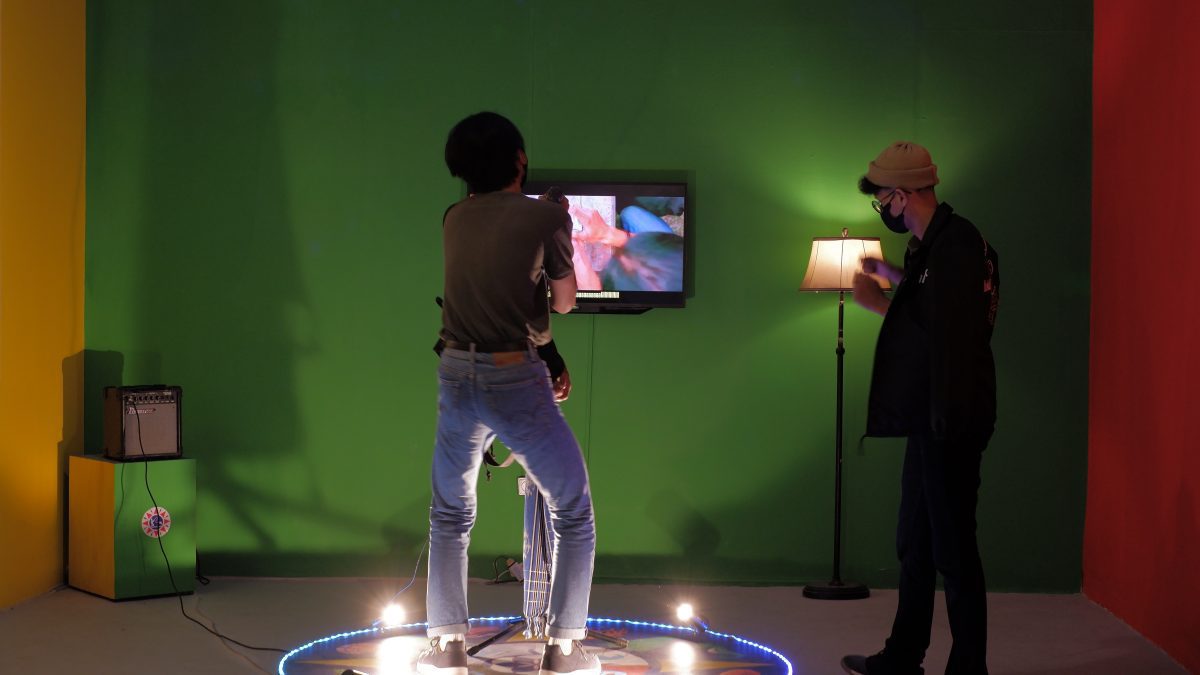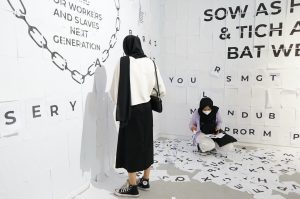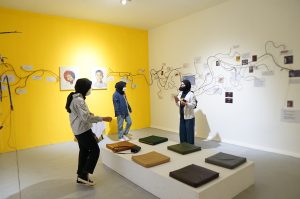
Instead of using an academic approach, Broken Pitch cultivates the narratives and ideas of Eastern decolonization offered by Juanga Culture in a low-brow style. Their projects present a playground as an interactive vehicle between artwork, narrative, and appreciation.
This is made possible by the works of Broken Pitch x Juanga Culture which treats space as installation work. Furthermore, the Broken Pitch experiment, as a visual element processor, opens up participatory opportunities for visitors to get involved in their art projects. In addition, this work also breaks down the wall of exclusivity that has been attached to works of art and the discourses it carries.
Consisting of three rooms that form a single Resource Room, the living room is transformed into a discotheque atmosphere, complete with colorful walls as well as a mini podium and microphone. The sound of hip-hop music with lyrics plastered on the walls, entitled “Boki Nukila vs. Kolonial” or “Boku Nulia vs. Colonial” tries to invite visitors to sing and sway to the rhythm of the music. This artistic intervention seeks to dismantle the knowledge heritage and territorial definitions of Indonesia and Oceania that we have known so far.
If you shift to the left, there is a white booth filled with papers and a photocopy machine in the middle of the room. On the walls slang words are scattered, one of which is framed in a chain of hearts: “universal slang for workers and slaves next generation”. It’s intended to provoke visitors to respond by composing swear words, curse words, or even outpourings that are taboo to be expressed in public spaces.
The image that appears in the presentation of this work is somewhat reminiscent of the writing style of the yellow newspaper—yellow “journalism”. With a language style that tends to be eccentric and inconsequential, yellow journalism presents sensational news with little information, leaning more towards arousing and stimulating the reader’s passion such as stories about crime, scandal, sex, gossip with misleading headlines.
 This yellow newspaper’s language style then allows for distortion and blurring of meaning. Through such style, the yellow newspaper builds its own concept that is shifted from the actual event. In addition, it can interfere with the reader’s process of picturing the event and becoming trapped in the perception that is built by the yellow newspaper news.
This yellow newspaper’s language style then allows for distortion and blurring of meaning. Through such style, the yellow newspaper builds its own concept that is shifted from the actual event. In addition, it can interfere with the reader’s process of picturing the event and becoming trapped in the perception that is built by the yellow newspaper news.
The perception presented by the yellow newspaper was already present in the minds of each of its consumers in the first place. Call it, sexism, vulgarity, eroticism, sensuality, and so on. The newspaper didn’t only play with perceptions, but often manipulate events to attract the attention of readers.
From here, because of its proximity to the yellow journalism communication mode, the “yellow plate” may be attached to the art pattern performed by Broken Pitch at the Biennale Jogja XVI Equator #6 2021.
Based on the explanation above, the next question is, is Broken Pitch able to bring the narrative they raised as context? Wouldn’t that distort their discourse?
Looking at Broken Pitch’s communication style towards appreciation, it can be traced through a similar pattern, one of which is the yellow newspaper. The emergence of the yellow newspaper is an attempt to meet the needs of “lower class newspapers”. This approach, in actuality, can reach the tastes of a wider community. Targeting the less educated lower class, in 2010-2012, the total circulation of Pos Kota—the pioneer of the yellow newspaper in Indonesia—reached 500,000 to 600,000 per day. In fact, in 2015, its popularity had beaten the daily newspaper Kompas. This figure is an illustration of how many of our people still have their tastes ignored by the mainstream media.
 Similar efforts have also been made by Broken Pitch with their lowbrow approach, namely reaching marginalized artists; those who are still far away and do not yet have access to a more networked art scene. The yellow plate is used by Broken Pitch as a vehicle that brings art into a more interactive space.
Similar efforts have also been made by Broken Pitch with their lowbrow approach, namely reaching marginalized artists; those who are still far away and do not yet have access to a more networked art scene. The yellow plate is used by Broken Pitch as a vehicle that brings art into a more interactive space.
If lowbrow communication is used by yellow journalism to explain something trivial in a “trivial” way, Broken Pitch uses this approach to explain something serious. As described by their work, Broken Pitch and Juanga Culture based their ideas on the discourse of marine culture in the Moluku Kie Raha region since the authority of sea kings such as Boki Nukila and Sultan Nuku; followed by sea people such as the Bajo Tribe; to pirate activity (lanun) in the waters of the archipelago at the end of the colonialism age.
Broken Pitch, which had already emerged as an anomaly, was once again experimenting in more absurd ways. The low-brow style, which is clearly an alternative in conveying ideas, cannot accommodate every problem. Especially on issues that require an in-depth discussion. They can only manage persuasive power and couldn’t facilitate their discourses into true discourse spaces.
Thus, the low-brow communication style, if attempted to be made into an art form to talk about third-world problems such as decolonization, is surely a too playful experiment, isn’t it?